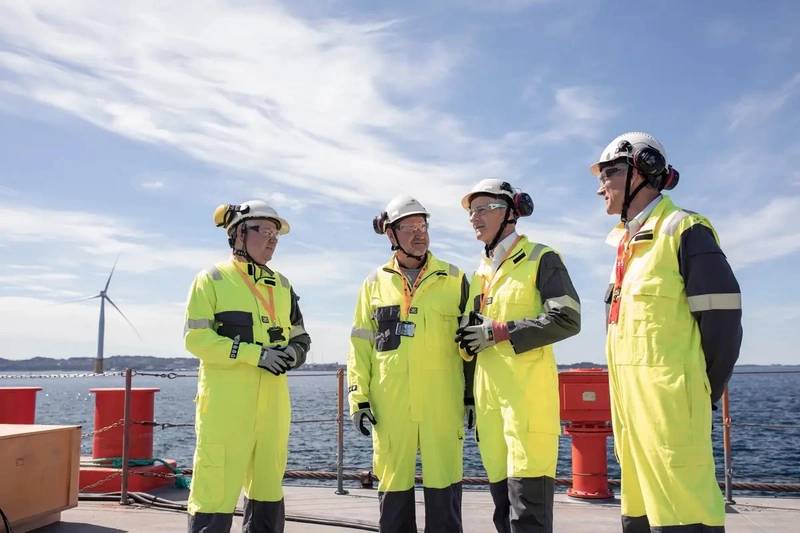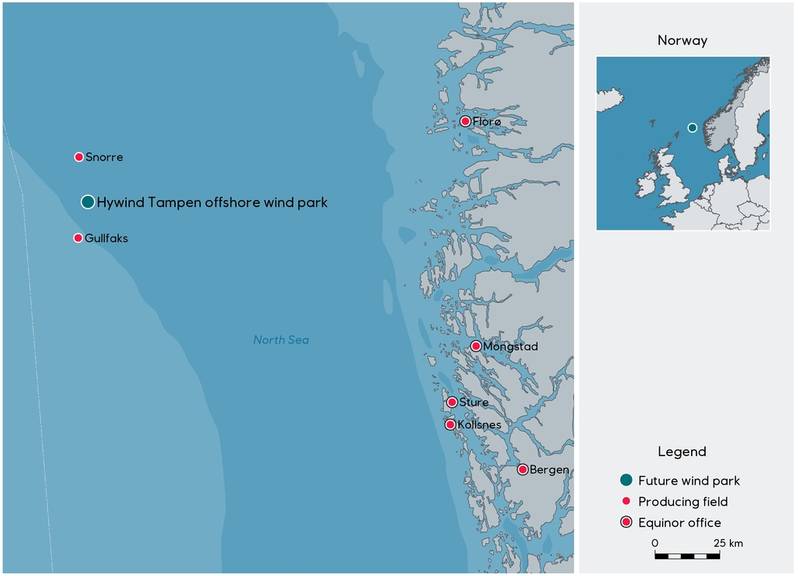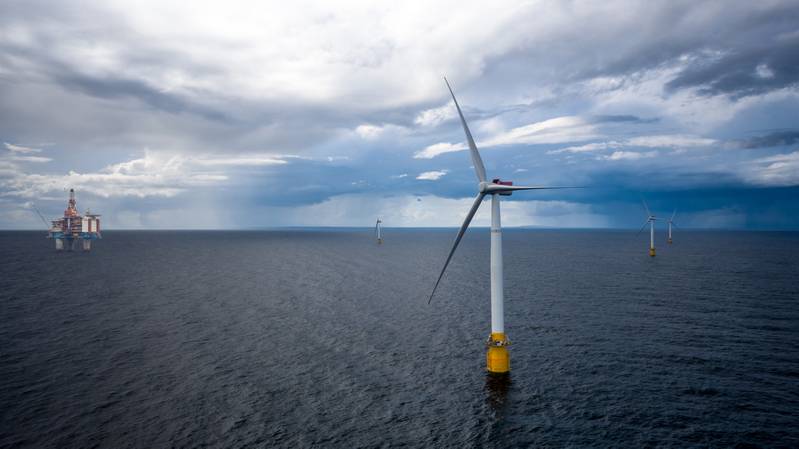
Norwegian prime minister Jonas Gahr Støre on Tuesday visited Wergeland Base in Gulen in Vestland County, Norway, to see the construction of floating wind turbines for the Hywind Tampen floating wind farm - the world's largest of the type.
"Four of the 11 wind turbines in Norway’s first offshore wind farm have now been installed, towering 190 meters over Fensfjorden before being towed out into the North Sea for offshore floating power generation," Equinor said. Worth noting, the first of 11 turbines last week set sail towards the offshore site in the North Sea, and reached it yesterday.
The 88MW Hywind Tampen will be the world’s largest floating offshore wind farm once completed later this year. With the scheduled to start up in the third quarter of 2022, it will serve as the power source for five of Equinor's offshore oil and gas platforms in the North Sea off Norway, Snorre A, and B, and Gullfaks A, B, and C. Norway approved Equinor's 4.8 billion Norwegian crowns plan to build the Hywind Tampen project back in April 2020.
According to a press statement by Equinor on Tuesday, during the Prime Minister's visit, LO President Peggy Hessen Følsvik, NHO Director General Ole Erik Almlid, and Enova CEO Nils Kristian Nakstad, accompanied the Prime Minster to Gulen, where they could see how Hywind Tampen will supply the Gullfaks and Snorre fields in the North Sea with electricity from floating offshore wind.
Expertise based on Oil and Gas
"Hywind Tampen proves that floating offshore wind can supply Norway with renewable power. Less than three years after we submitted plans for development and operation, we can now point to the result of good cooperation between authorities and the industry to make floating offshore wind a reality. The next step is to develop larger floating offshore wind projects in the North Sea. This is possible because the industry and the authorities have been bold and helped develop a supplier industry for offshore wind based on expertise from the oil and gas industry," says Pål Eitrheim, Equinor's executive vice president for Renewables.
Pål Eitrheim (left), executive vice president for Renewables, Geir Tungesvik, executive vice president for Projects, Drilling & Procurement, prime minister Jonas Gahr Støre and Olav-Bernt Haga, Hywind Tampen project manager.
(Photo: Ole Jørgen Bratland / Equinor ASA)
Norwegian suppliers' contribution at 50%
Along with Geir Tungesvik, Equinor's executive vice president for Projects, Drilling & Procurement, and project director for Hywind Tampen Olav-Bernt Haga, the delegation was given a tour of the assembly area for the offshore wind turbines. A total of 7 primary suppliers and a large number of subcontractors have contributed to the project, with a contribution rate from Norwegian suppliers of about 50%, Equinor said.
"With Hywind Tampen, we've laid the groundwork for new industrial opportunities for Norway and the Norwegian supplier industry in an increasingly global market. Commissioning new and larger turbines, new installation methods, concrete structures and interaction between power generation systems are being tested and further developed. The offshore windfarm we're in the process of completing is unique, not only in Norway, but worldwide, says Geir Tungesvik, Equinor's executive vice president for Projects, Drilling & Procurement.
At Wergeland Base in Gulen in Vestland County, the tower structure, turbine housing, and blades are mounted before being towed 140 km out to the Snorre and Gullfaks fields, where the offshore wind farm will be supplying power to the installations.
 Credit: Equinor88MW
Credit: Equinor88MW
The wind farm will have a total system capacity of 88 MW, which will presumably cover about 35 percent of the annual power needs on the five platforms Snorre A and B and Gullfaks A, B, and C. This will reduce the need for locally produced gas power on the fields and thus reduce annual emissions from the fields by about 200,000 tonnes of CO2, which is equivalent to emissions from 100,000 vehicles, Equinor said.
The substructures are cast in concrete, using the same technology as the legs for the Troll platform, and are a total of 107.5 meters tall. With the turbine installed on top, 90 meters will be underwater; the rotor has a diameter of 167 meters and the blades are 81.5 meters long.
Project costs total around NOK 5 billion (around $523 million). Equinor and its partners, Petoro, OMV, Vår Energi, Wintershall Dea, and INPEX Idemitsu Norge AS, have been awarded NOK 2.3 billion ($240,7 million) in Enova support and NOK 566 million (around $59,2 million) from the NOx Fund.
"This support has helped further develop the technology to further enable commercialization of floating offshore wind on a large scale moving forward," Equinor said.
The Norwegian government has the ambition to produce almost as much new electricity from offshore wind as Norway currently produces today and is planning 30 GW of offshore wind by 2040.
There's currently a little over 100 MW of floating wind installed worldwide, all of it in Europe, with Hywind Tampen set to nearly double the currently installed capacity.
While the currently installed floating wind capacity is still minuscule compared to fixed-bottom offshore wind, Wind Europe recently noted that the floating wind industry is developing rapidly, and could, only in Europe, jump from the currently installed 113 MW floating wind turbines to 330 MW in 2024, and possibly 10GW by 2030, based on ambitions and targets announced by Norway, France, Span, Greece, Portugal, Italy, Scotland, and Ireland.
